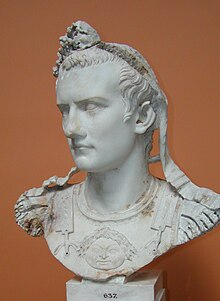Emperor Caligula
| Latin: Gaius Julius Caesar Germanicus | |||||
|---|---|---|---|---|---|

Reconstructed bust of the Emperor Gaius, known as Caligula
|
|||||
| 3rd Emperor of the Roman Empire | |||||
| Reign | 18 March AD 37 – 24 January AD 41 (3 years, 10 months) |
||||
| Predecessor | Tiberius, grand uncle and adoptive grandfather | ||||
| Successor | Claudius, uncle | ||||
| Born | 31 August AD 12 Antium (modern Anzio and Nettuno), Italy |
||||
| Died | 24 January AD 41 (aged 28) Palatine Hill, Rome |
||||
| Burial | Mausoleum of Augustus, Rome | ||||
| Spouse | |||||
| Issue |
|
||||
|
|||||
| House | Julio-Claudian dynasty | ||||
| Father | Germanicus | ||||
| Mother | Agrippina the Elder | ||||
| Religion | ancient Roman religion | ||||
| Full name | |
|---|---|
|
| Roman imperial dynasties | |||
| Julio-Claudian dynasty | |||
| Chronology | |||
| Augustus | 27 BC – 14 AD | ||
| Tiberius | 14–37 AD | ||
| Caligula | 37–41 AD | ||
| Claudius | 41–54 AD | ||
| Nero | 54–68 AD | ||
| Family | |||
|
Gens Julia Gens Claudia Julio-Claudian family tree Category:Julio-Claudian dynasty |
|||
| Succession | |||
|
Preceded by Roman Republic |
Followed by Year of the Four Emperors |
||
Caligula (/kəˈlɪɡjᵿlə/), properly Gaius Julius Caesar Augustus Germanicus (31 August AD 12 – 24 January AD 41) was Roman emperor from AD 37–41. Born Gaius Julius Caesar Germanicus (not to be confused with Julius Caesar), Caligula was a member of the house of rulers conventionally known as the Julio-Claudian dynasty. Caligula's biological father was Germanicus, and he was the great-nephew and adopted son of Emperor Tiberius. The young Gaius earned the nickname "Caligula" (meaning "little soldier's boot", the diminutive form of caliga, hob-nailed military boot) from his father's soldiers while accompanying him during his campaigns in Germania.
When Germanicus died at Antioch in AD 19, his wife Agrippina the Elder returned with her six children to Rome, where she became entangled in a bitter feud with Tiberius. The conflict eventually led to the destruction of her family, with Caligula as the sole male survivor. Untouched by the deadly intrigues, Caligula accepted the invitation to join the Emperor in AD 31 on the island of Capri, where Tiberius had withdrawn five years earlier. With the death of Tiberius in AD 37, Caligula succeeded his grand uncle and adoptive grandfather as emperor.
There are few surviving sources about the reign of Emperor Caligula, although he is described as a noble and moderate ruler during the first six months of his reign. After this, the sources focus upon his cruelty, sadism, extravagance, and sexual perversity, presenting him as an insane tyrant. While the reliability of these sources is questionable, it is known that during his brief reign, Caligula worked to increase the unconstrained personal power of the emperor, as opposed to countervailing powers within the principate. He directed much of his attention to ambitious construction projects and luxurious dwellings for himself, and initiated the construction of two aqueducts in Rome: the Aqua Claudia and the Anio Novus. During his reign, the empire annexed the Kingdom of Mauretania as a province.
...
Wikipedia
